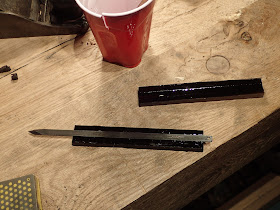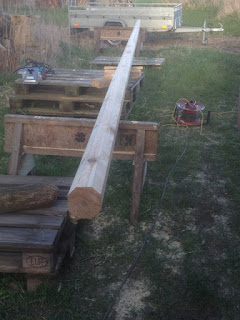Skill in woodworking is often gained by making mistakes. We learn from those mistakes and apply the knowledge and wisdom gained from those experiences in our work from then on.
This means that I am now a WAYYYY better woodworker than I was before I started this project.
I began with the firm knowledge this table was designed to be built in a way that takes advantage of machine production and multiple batches. Something that hand work isn't really known for. I figured that I should be able to do this one freaking table, and looking at photos of the original I determined it shouldn't be too difficult to build.
In the end a drawing or a proper mock-up in construction lumber or something probably would have given me the information that I needed to find success with this build. I suppose that's lesson #1.
You may remember where I left off with this table was with a completed base.
 |
| Base #1. It looks great from this angle. |
 |
| Up close, not so much. |
The problem resulted from cutting and fitting each individual joint. Once it was all together I decided to change which joints went where. The reason for this I wrote about in an earlier post, but in a nutshell, it was for structural reasons (Lesson #1 would have prevented this mistake).
One choice tidbit of information I got from this process was the fact that there were only three unique parts for this table using my chosen joinery technique of only lap joints. That means that theoretically, I could gang cut the parts with only three setups and save the weeks of time I wasted on the first one. Also, if the parts are all exactly the same, they can go together in any order yielding fewer chances to screw up putting one of sixteen parts in the wrong place.
I therefore milled up a bunch more stock for this project.
 |
| This time I did this part all with machines. |
I spent a couple hours at the workshop at Dictum. I ripped each stick from the rough board with a unique angle on the table saw in order to get perfectly rift-sawn stuff for each stick. This does create a lot of waste, but it is worth it as these sticks, just like the ones on failed attempt #1, looked perfect.
Here was my plan for yesterday:
- Clamp all the sticks up, mark the length and location of the lap joints.
- Saw a cross-grain groove to 50% depth on each side.
- Remove waste with a chisel and clean up the groove with a router plane.
- Turn all pieces to the next face to cut the joints on the ends using the same method.
- Cut to length.
- Admire my flawless work.
Things started out well, but went south in a hurry.
 |
| One clamp turned out to be enough. Win! |
 |
| I used some care clamping this batten down to guide my first saw cut. Win! |
 |
| I made a perfect first cut easily with this method. Win! |
 |
| I clamped a second batten down using a piece of milled material for spacing. Great idea in theory, but let's wait and see before declaring this a good technique. |
 |
| As you can see, it is simple to make some very accurate saw cuts this way. Win! |
 |
| Here you can see the whole setup with saw cuts. The line on the very right is where I will eventually saw these sticks to length. No need to do that yet, that extra length might come in handy for clamping or support. |
 |
| It appears to have worked perfectly. Win! (Don't get cocky. That's probably lesson #2!) |
Let's try it on the other side, now.
 |
| Carefully lay out and clamp a batten for a saw guide. |
I guess after this step I got in too much of a hurry to take more pictures. I probably could see where I went wrong if I did. I thought I did it just the same as the first groove.
 |
| Once done sawing, I roughed out the grooves with a chisel and cleaned up with a router. |
 |
| Obligatory art photo. |
I have to say, at this point things look great. Much nicer than the laps I did on Failed Attempt #1.
 |
| Pretty! |
The true test is if the laps actually fit together. Since I could now remove my clamp, I tested the joints.
 |
| Not super tight, but I could live with this. These are the laps from the first side. |
 |
| Holy crap! This is almost an entire saw-kerf sized gap. Now what? |
I decided to stop at this point, step back and think about what happened.
Having spent a day thinking about it, I am definitely not happy with the bottom joint. Unfortunately, eight sticks out of the required twelve (four will get cut in half to make the uprights) have this gappy, too-wide and loose joint. I have decided that I will have to start over on this one yet again. My standards are higher than this. After all, what was the reason I was doing this over? Oh yeah, because the joints were gappy.
What was my mistake?
Well, looking back, it was how I laid out the second saw cut. Technically on paper it should have worked to lay out the second batten using a piece of stock for a spacer, but there is a high risk that something could move just a little somewhere. Also, I think the first joint worked perfectly, yet it wasn't
quite as tight as I had hoped. No matter how tight I get it up against the first batten, it won't be a little too tight giving me the tight friction fit I am after. Why didn't I do a test cut? I suppose it is because I hadn't completely grasped lesson #1 yet.
Next time I will mark out the second saw cut with some kind of marking tool. Perhaps dividers would work in order to scratch a line parallel and a perfect distance from the first cut. Then, I should set my second batten up to that line. I could then ensure that this saw cut is just a whisker less than what I did here, and all the joints will look perfect.
In the mean time, I am going to take a little break from this project. I will probably finish the top and store it on top of Failed Attempt #1, just so it looks like we have a coffee table. I will have to live with those gappy joints in the meantime, but this will result in eventually getting back to this project. I will have to mill some more lumber.
In the meantime, I need to start thinking more about my June Chair Build!
Earlier posts on this project are here:
Part I
Part II
Part III
Part IV
Part V






















































